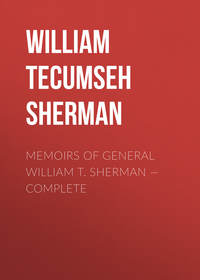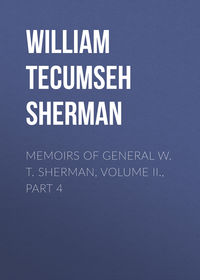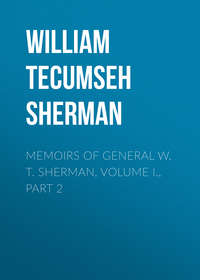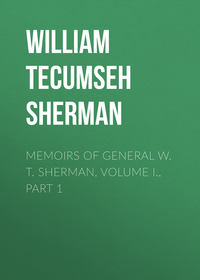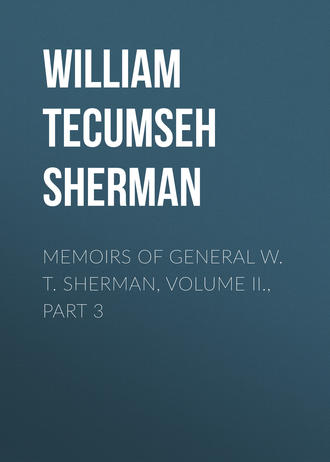 полная версия
полная версияMemoirs of General W. T. Sherman, Volume II., Part 3
That night I received further notice from McPherson that he had found Resaca too strong for a surprise; that in consequence he had fallen back three miles to the month of Snake Creek Gap, and was there fortified. I wrote him the next day the following letters, copies of which are in my letter-book; but his to me were mere notes in pencil, not retained:
HEADQUARTERS MILITARY DIVISION OF THE MISSISSIPPI IN THE FIELD, TUNNEL HILL, GEORGIA, May 11, 1864
Major-General McPHERSON, commanding army of the Tennessee, Sugar Valley, Georgia.
GENERAL: I received by courier (in the night) yours of 5 and 8.30 P. M. of yesterday.
You now have your twenty-three thousand men, and General Hooker is in close support, so that you can hold all of Jos. Johnston's army in check should he abandon Dalton. He cannot afford to abandon Dalton, for he has fixed it up on purpose to receive us, and he observes that we are close at hand, waiting for him to quit. He cannot afford a detachment strong enough to fight you, as his army will not admit of it.
Strengthen your position; fight any thing that comes; and threaten the safety of the railroad all the time. But, to tell the truth, I would rather the enemy would stay in Dalton two more days, when he may find in his rear a larger party than he expects in an open field. At all events, we can then choose our own ground, and he will be forced to move out of his works. I do not intend to put a column into Buzzard-Roost Gap at present.
See that you are in easy communication with me and with all head-quarters. After to-day the supplies will be at Ringgold. Yours, W. T. SHERMAN, Major-General commanding.
HEADQUARTERS MILITARY DIVISION OF THE MISSISSIPPI IN THE FIELD, TUNNEL HILL, GEORGIA, May 11, 1864-Evening
Major-General McPHERSON, commanding army of the Tennessee, Sugar Valley, Georgia
GENERAL: The indications are that Johnston is evacuating Dalton. In that event, Howard's corps and the cavalry will pursue; all the rest will follow your route. I will be down early in the morning.
Try to strike him if possible about the forks of the road.
Hooker must be with you now, and you may send General Garrard by Summerville to threaten Rome and that flank. I will cause all the lines to be felt at once.
W. T. SHERMAN, major-general commanding.
McPherson had startled Johnston in his fancied security, but had not done the full measure of his work. He had in hand twenty-three thousand of the best men of the army, and could have walked into Resaca (then held only by a small brigade), or he could have placed his whole force astride the railroad above Resaca, and there have easily withstood the attack of all of Johnston's army, with the knowledge that Thomas and Schofield were on his heels. Had he done so, I am certain that Johnston would not have ventured to attack him in position, but would have retreated eastward by Spring Place, and we should have captured half his army and all his artillery and wagons at the very beginning of the campaign.
Such an opportunity does not occur twice in a single life, but at the critical moment McPherson seems to have been a little cautious. Still, he was perfectly justified by his orders, and fell back and assumed an unassailable defensive position in Sugar Valley, on the Resaca side of Snake-Creek Gap. As soon as informed of this, I determined to pass the whole army through Snake-Creek Gap, and to move on Resaca with the main army.
But during the 10th, the enemy showed no signs of evacuating Dalton, and I was waiting for the arrival of Garrard's and Stoneman's cavalry, known to be near at hand, so as to secure the full advantages of victory, of which I felt certain. Hooker's Twentieth Corps was at once moved down to within easy supporting distance of McPherson; and on the 11th, perceiving signs of evacuation of Dalton, I gave all the orders for the general movement, leaving the Fourth Corps (Howard) and Stoneman's cavalry in observation in front of Buzzard-Roost Gap, and directing all the rest of the army to march through Snake-Creek Gap, straight on Resaca. The roads were only such as the country afforded, mere rough wagon-ways, and these converged to the single narrow track through Snake-Creek Gap; but during the 12th and 13th the bulk of Thomas's and Schofield's armies were got through, and deployed against Resaca, McPherson on the right, Thomas in the centre, and Schofield on the left. Johnston, as I anticipated, had abandoned all his well-prepared defenses at Dalton, and was found inside of Resaca with the bulk of his army, holding his divisions well in hand, acting purely on the defensive, and fighting well at all points of conflict. A complete line of intrenchments was found covering the place, and this was strongly manned at all points. On the 14th we closed in, enveloping the town on its north and west, and during the 15th we had a day of continual battle and skirmish. At the same time I caused two pontoon-bridges to be laid across the Oostenaula River at Lay's Ferry, about three miles below the town, by which we could threaten Calhoun, a station on the railroad seven miles below Resaca. At the same time, May 14th, I dispatched General Garrard, with his cavalry division, down the Oostenaula by the Rome road, with orders to cross over, if possible, and to attack or threaten the railroad at any point below Calhoun and above Kingston.
During the 15th, without attempting to assault the fortified works, we pressed at all points, and the sound of cannon and musketry rose all day to the dignity of a battle. Toward evening McPherson moved his whole line of battle forward, till he had gained a ridge overlooking the town, from which his field-artillery could reach the railroad-bridge across the Oostenaula. The enemy made several attempts to drive him away, repeating the sallies several times, and extending them into the night; but in every instance he was repulsed with bloody loss.
Hooker's corps had also some heavy and handsome fighting that afternoon and night on the left, where the Dalton roan entered the intrenchments, capturing a four-gun intrenched battery, with its men and guns; and generally all our men showed the finest fighting qualities.
Howard's corps had followed Johnston down from Dalton, and was in line; Stoneman's division of cavalry had also got up, and was on the extreme left, beyond the Oostenaula.
On the night of May 15th Johnston got his army across the bridges, set them on fire, and we entered Resaca at daylight. Our loss up to that time was about six hundred dead and thirty-three hundred and seventy-five wounded—mostly light wounds that did not necessitate sending the men to the rear for treatment. That Johnston had deliberately designed in advance to give up such strong positions as Dalton and Resaca, for the purpose of drawing us farther south, is simply absurd. Had he remained in Dalton another hour, it would have been his total defeat, and he only evacuated Resaca because his safety demanded it. The movement by us through Snake-Creek Gap was a total surprise to him. My army about doubled his in size, but he had all the advantages of natural positions, of artificial forts and roads, and of concentrated action. We were compelled to grope our way through forests, across mountains, with a large army, necessarily more or less dispersed. Of course, I was disappointed not to have crippled his, army more at that particular stage of the game; but, as it resulted, these rapid successes gave us the initiative, and the usual impulse of a conquering army.
Johnston having retreated in the night of May 15th, immediate pursuit was begun. A division of infantry (Jeff. C. Davis's) was at once dispatched down the valley toward Rome, to support Garrard's cavalry, and the whole army was ordered to pursue, McPherson by Lay's Ferry, on the right, Thomas directly by the railroad, and Schofield by the left, by the old road that crossed the Oostenaula above Echota or Newtown.
We hastily repaired the railroad bridge at Resaca, which had been partially burned, and built a temporary floating bridge out of timber and materials found on the spot; so that Thomas got his advance corps over during the 16th, and marched as far as Calhoun, where he came into communication with McPherson's troops, which had crossed the Oostenaula at Lay's Ferry by our pontoon-bridges, previously laid. Inasmuch as the bridge at Resaca was overtaxed, Hooker's Twentieth Corps was also diverted to cross by the fords and ferries above Resaca, in the neighborhood of Echota.
On the 17th, toward evening, the head of Thomas's column, Newton's division, encountered the rear-guard of Johnston's army near Adairsville. I was near the head of column at the time, trying to get a view of the position of the enemy from an elevation in an open field. My party attracted the fire of a battery; a shell passed through the group of staff-officers and burst just beyond, which scattered us promptly. The next morning the enemy had disappeared, and our pursuit was continued to Kingston, which we reached during Sunday forenoon, the 19th.
From Resaca the railroad runs nearly due south, but at Kingston it makes junction with another railroad from Rome, and changes direction due east. At that time McPherson's head of column was about four miles to the west of Kingston, at a country place called "Woodlawn;" Schofield and Hooker were on the direct roads leading from Newtown to Casaville, diagonal to the route followed by Thomas. Thomas's head of column, which had followed the country roads alongside of the railroad, was about four miles east of Kingston, toward Cassville, when about noon I got a message from him that he had found the enemy, drawn up in line of battle, on some extensive, open ground, about half-way between Kingston and Cassville, and that appearances indicated a willingness and preparation for battle.
Hurriedly sending orders to McPherson to resume the march, to hasten forward by roads leading to the south of Kingston, so as to leave for Thomas's troops and trains the use of the main road, and to come up on his right, I rode forward rapidly, over some rough gravel hills, and about six miles from Kingston found General Thomas, with his troops deployed; but he reported that the enemy had fallen back in echelon of divisions, steadily and in superb order, into Cassville. I knew that the roads by which Generals Hooker and Schofield were approaching would lead them to a seminary near Cassville, and that it was all-important to secure the point of junction of these roads with the main road along which we were marching. Therefore I ordered General Thomas to push forward his deployed lines as rapidly as possible; and, as night was approaching, I ordered two field-batteries to close up at a gallop on some woods which lay between us and the town of Cassville. We could not see the town by reason of these woods, but a high range of hills just back of the town was visible over the tree-tops. On these hills could be seen fresh-made parapets, and the movements of men, against whom I directed the artillery to fire at long range. The stout resistance made by the enemy along our whole front of a couple of miles indicated a purpose to fight at Cassville; and, as the night was closing in, General Thomas and I were together, along with our skirmish-lines near the seminary, on the edge of the town, where musket-bullets from the enemy were cutting the leaves of the trees pretty thickly about us. Either Thomas or I remarked that that was not the place for the two senior officers of a great army, and we personally went back to the battery, where we passed the night on the ground. During the night I had reports from McPherson, Hooker, and Schofield. The former was about five miles to my right rear, near the "nitre-caves;" Schofield was about six miles north, and Hooker between us, within two miles. All were ordered to close down on Cassville at daylight, and to attack the enemy wherever found. Skirmishing was kept up all night, but when day broke the next morning, May 20th, the enemy was gone, and our cavalry was sent in pursuit. These reported him beyond the Etowah River. We were then well in advance of our railroad-trains, on which we depended for supplies; so I determined to pause a few days to repair the railroad, which had been damaged but little, except at the bridge at Resaca, and then to go on.
Nearly all the people of the country seemed to have fled with Johnston's army; yet some few families remained, and from one of them I procured the copy of an order which Johnston had made at Adairsville, in which he recited that he had retreated as far as strategy required, and that his army must be prepared for battle at Cassville. The newspapers of the South, many of which we found, were also loud in denunciation of Johnston's falling back before us without a serious battle, simply resisting by his skirmish-lines and by his rear-guard. But his friends proclaimed that it was all strategic; that he was deliberately drawing us farther and farther into the meshes, farther and farther away from our base of supplies, and that in due season he would not only halt for battle, but assume the bold offensive. Of course it was to my interest to bring him to battle as soon as possible, when our numerical superiority was at the greatest; for he was picking up his detachments as he fell back, whereas I was compelled to make similar and stronger detachments to repair the railroads as we advanced, and to guard them. I found at Cassville many evidences of preparation for a grand battle, among them a long line of fresh intrenchments on the hill beyond the town, extending nearly three miles to the south, embracing the railroad-crossing. I was also convinced that the whole of Polk's corps had joined Johnston from Mississippi, and that he had in hand three full corps, viz., Hood's, Polk's, and Hardee's, numbering about sixty thousand men, and could not then imagine why he had declined battle, and did not learn the real reason till after the war was over, and then from General Johnston himself.
In the autumn of 1865, when in command of the Military Division of the Missouri, I went from St. Louis to Little Rock, Arkansas, and afterward to Memphis. Taking a steamer for Cairo, I found as fellow-passengers Generals Johnston and Frank Blair. We were, of course, on the most friendly terms, and on our way up we talked over our battles again, played cards, and questioned each other as to particular parts of our mutual conduct in the game of war. I told Johnston that I had seen his order of preparation, in the nature of an address to his army, announcing his purpose to retreat no more, but to accept battle at Cassville. He answered that such was his purpose; that he had left Hardee's corps in the open fields to check Thomas, and gain time for his formation on the ridge, just behind Cassville; and it was this corps which General Thomas had seen deployed, and whose handsome movement in retreat he had reported in such complimentary terms. Johnston described how he had placed Hood's corps on the right, Polk's in the centre, and Hardee's on the left. He said he had ridden over the ground, given to each corps commander his position, and orders to throw up parapets during the night; that he was with Hardee on his extreme left as the night closed in, and as Hardee's troops fell back to the position assigned them for the intended battle of the next day; and that, after giving Hardee some general instructions, he and his staff rode back to Cassville. As he entered the town, or village, he met Generals Hood and Polk. Hood inquired of him if he had had any thing to eat, and he said no, that he was both hungry and tired, when Hood invited him to go and share a supper which had been prepared for him at a house close by. At the supper they discussed the chances of the impending battle, when Hood spoke of the ground assigned him as being enfiladed by our (Union) artillery, which Johnston disputed, when General Polk chimed in with the remark that General Hood was right; that the cannon-shots fired by us at nightfall had enfiladed their general line of battle, and that for this reason he feared they could not hold their men. General Johnston was surprised at this, for he understood General Hood to be one of those who professed to criticise his strategy, contending that, instead of retreating, he should have risked a battle. General Johnston said he was provoked, accused them of having been in conference, with being beaten before battle, and added that he was unwilling to engage in a critical battle with an army so superior to his own in numbers, with two of his three corps commanders dissatisfied with the ground and positions assigned them. He then and there made up his mind to retreat still farther south, to put the Etowah River and the Allatoona range between us; and he at once gave orders to resume the retrograde movement.
This was my recollection of the substance of the conversation, of which I made no note at the time; but, at a meeting of the Society of the Army of the Cumberland some years after, at Cleveland, Ohio, about 1868, in a short after-dinner speech, I related this conversation, and it got into print. Subsequently, in the spring of 1870, when I was at New Orleans, on route for Texas, General Hood called to see me at the St. Charles Hotel, explained that he had seen my speech reprinted in the newspapers and gave me his version of the same event, describing the halt at Cassville, the general orders for battle on that ground, and the meeting at supper with Generals Johnston and Polk, when the chances of the battle to be fought the next day were freely and fully discussed; and he stated that he had argued against fighting the battle purely on the defensive, but had asked General Johnston to permit him with his own corps and part of Polk's to quit their lines, and to march rapidly to attack and overwhelm Schofield, who was known to be separated from Thomas by an interval of nearly five miles, claiming that he could have defeated Schofield, and got back to his position in time to meet General Thomas's attack in front. He also stated that he had then contended with Johnston for the "offensive-defensive" game, instead of the "pure defensive," as proposed by General Johnston; and he said that it was at this time that General Johnston had taken offense, and that it was for this reason he had ordered the retreat that night. As subsequent events estranged these two officers, it is very natural they should now differ on this point; but it was sufficient for us that the rebel army did retreat that night, leaving us masters of all the country above the Etowah River.
For the purposes of rest, to give time for the repair of the railroads, and to replenish supplies, we lay by some few days in that quarter—Schofield with Stoneman's cavalry holding the ground at Cassville Depot, Cartersville, and the Etowah Bridge; Thomas holding his ground near Cassville, and McPherson that near Kingston. The officer intrusted with the repair of the railroads was Colonel W. W. Wright, a railroad-engineer, who, with about two thousand men, was so industrious and skillful that the bridge at Resaca was rebuilt in three days, and cars loaded with stores came forward to Kingston on the 24th. The telegraph also brought us the news of the bloody and desperate battles of the Wilderness, in Virginia, and that General Grant was pushing his operations against Lee with terrific energy. I was therefore resolved to give my enemy no rest.
In early days (1844), when a lieutenant of the Third Artillery, I had been sent from Charleston, South Carolina, to Marietta, Georgia, to assist Inspector-General Churchill to take testimony concerning certain losses of horses and accoutrements by the Georgia Volunteers during the Florida War; and after completing the work at Marietta we transferred our party over to Bellefonte, Alabama. I had ridden the distance on horseback, and had noted well the topography of the country, especially that about Kenesaw, Allatoona, and the Etowah River. On that occasion I had stopped some days with a Colonel Tumlin, to see some remarkable Indian mounds on the Etowah River, usually called the "Hightower:" I therefore knew that the Allatoona Pass was very strong, would be hard to force, and resolved not even to attempt it, but to turn the position, by moving from Kingston to Marietta via. Dallas; accordingly I made orders on the 20th to get ready for the march to begin on the 23d. The Army of the Cumberland was ordered to march for Dallas, by Euharlee and Stilesboro; Davis's division, then in Rome, by Van Wert; the Army of the Ohio to keep on the left of Thomas, by a place called Burnt Hickory; and the Army of the Tennessee to march for a position a little to the south, so as to be on the right of the general army, when grouped about Dallas.
The movement contemplated leaving our railroad, and to depend for twenty days on the contents of our wagons; and as the country was very obscure, mostly in a state of nature, densely wooded, and with few roads, our movements were necessarily slow. We crossed the Etowah by several bridges and fords, and took as many roads as possible, keeping up communication by cross-roads, or by couriers through the woods. I personally joined General Thomas, who had the centre, and was consequently the main column, or "column of direction." The several columns followed generally the valley of the Euharlee, a tributary coming into the Etowah from the south, and gradually crossed over a ridge of mountains, parts of which had once been worked over for gold, and were consequently full of paths and unused wagon-roads or tracks. A cavalry picket of the enemy at Burnt Hickory was captured, and had on his person an order from General Johnston, dated at Allatoona, which showed that he had detected my purpose of turning his position, and it accordingly became necessary to use great caution, lest some of the minor columns should fall into ambush, but, luckily the enemy was not much more familiar with that part of the country than we were. On the other side of the Allatoona range, the Pumpkin-Vine Creek, also a tributary of the Etowah, flowed north and west; Dallas, the point aimed at, was a small town on the other or east side of this creek, and was the point of concentration of a great many roads that led in every direction. Its possession would be a threat to Marietta and Atlanta, but I could not then venture to attempt either, till I had regained the use of the railroad, at least as far down as its debouche from the Allatoona range of mountains. Therefore, the movement was chiefly designed to compel Johnston to give up Allatoona.
On the 25th all the columns were moving steadily on Dallas—McPherson and Davis away off to the right, near Van Wert; Thomas on the main road in the centre, with Hooker's Twentieth Corps ahead, toward Dallas; and Schofield to the left rear. For the convenience of march, Hooker had his three divisions on separate roads, all leading toward Dallas, when, in the afternoon, as he approached a bridge across Pumpkin-Vine Creek, he found it held by a cavalry force, which was driven off, but the bridge was on fire. This fire was extinguished, and Hooker's leading division (Geary's) followed the retreating cavalry on a road leading due east toward Marietta, instead of Dallas. This leading division, about four miles out from the bridge, struck a heavy infantry force, which was moving down from Allatoona toward Dallas, and a sharp battle ensued. I came up in person soon after, and as my map showed that we were near an important cross-road called "New Hope," from a Methodist meeting-house there of that name, I ordered General Hooker to secure it if possible that night. He asked for a short delay, till he could bring up his other two divisions. viz., of Butterfield and Williams, but before these divisions had got up and were deployed, the enemy had also gained corresponding strength. The woods were so dense, and the resistance so spirited, that Hooker could not carry the position, though the battle was noisy, and prolonged far into the night. This point, "New Hope," was the accidental intersection of the road leading from Allatoona to Dallas with that from Van Wert to Marietta, was four miles northeast of Dallas, and from the bloody fighting there for the next week was called by the soldiers "Hell-Hole."
The night was pitch-dark, it rained hard, and the convergence of our columns toward Dallas produced much confusion. I am sure similar confusion existed in the army opposed to us, for we were all mixed up. I slept on the ground, without cover, alongside of a log, got little sleep, resolved at daylight to renew the battle, and to make a lodgment on the Dallas and Allatoona road if possible, but the morning revealed a strong line of intrenchments facing us, with a heavy force of infantry and guns. The battle was renewed, and without success. McPherson reached Dallas that morning, viz., the 26th, and deployed his troops to the southeast and east of the town, placing Davis's division of the Fourteenth Corps, which had joined him on the road from Rome, on his left; but this still left a gap of at least three miles between Davis and Hooker. Meantime, also, General Schofield was closing up on Thomas's left.


